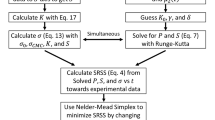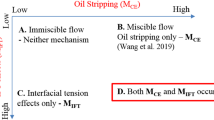Abstract
The focus of this paper is the derivation of a nonstandard model for microbial enhanced oil recovery (MEOR) that includes the interfacial area (IFA) between oil and water. We consider the continuity equations for water and oil, a balance equation for the oil–water interfacial area, and advective–dispersive transport equations for bacteria, nutrients, and biosurfactants. Surfactants lower the interfacial tension (IFT), which improves oil recovery. Therefore, the parametrizations of the IFT reduction and residual oil saturation are included as a function of the surfactant concentration in the model. We consider for the first time in context of MEOR, the role of IFA in enhanced oil recovery. The motivation to include the IFA is to model the hysteresis in the capillary pressure–saturation relationship in a physically based manner, to include the effects of observed bacteria migration toward the oil–water interface and the production of biosurfactants at the oil–water interface. A comprehensive 2D implementation based on two-point flux approximation and backward Euler is proposed. An efficient and robust linearization scheme is used to solve the nonlinear systems at each time step. Illustrative numerical simulations are presented. The differences in the oil recovery profiles obtained with and without IFA are discussed. The presented model can also be used to design new experiments toward a better understanding and eventually optimization of MEOR.








Similar content being viewed by others
Abbreviations
- A :
-
Cross-sectional area
- \(a_\mathrm{ow}\) :
-
Specific oil–water IFA
- \(C_\mathrm{b},\;C_\mathrm{n},\;C_\mathrm{s}\) :
-
Bacterial, nutrient, and surfactant concentration
- \(C^*_\mathrm{n}\) :
-
Critical nutrient concentration for metabolism
- \(d_1\) :
-
Bacterial decay rate coefficient
- \(D_\mathrm{b}^{\text {eff}},\;D_\mathrm{n}^{\text {eff}},\;D_\mathrm{s}^{\text {eff}}\) :
-
Effective diffusion coefficients
- \(E_\mathrm{ow}\) :
-
Production rate of specific IFA
- \(e_\mathrm{ow}\) :
-
Strength of change of specific IFA
- F :
-
Source/sink term
- \(\mathbf{g }\) :
-
Gravity
- \(g_{1\;{\text {max}}}\) :
-
Maximum bacterial growth rate coefficient
- \(\mathbf{k },\;\mathbf{k }_\mathrm{o},\;\mathbf{k }_\mathrm{w}\) :
-
Absolute, oil, and water effective permeabilities
- \(k_\mathrm{a}\) :
-
Diffusion coefficient for the chemotaxis
- \(k_\mathrm{r,o},\;k_\mathrm{r,w}\) :
-
Oil and water relative permeabilities
- \(\mathbf{k }_\mathrm{ow}\) :
-
Interfacial permeability
- \(K_\mathrm{b/n},\;K_\mathrm{s/n}\) :
-
Saturation constants for bacteria and surfactants on nutrients
- \(K_\mathrm{s/a}\) :
-
Saturation constant for surfactants on IFA
- \(l_1,\;l_2,\;l_3\) :
-
Fitting parameters for modeling the reduction of IFT
- L :
-
Length of porous medium
- \(N_\text {B}\) :
-
Bond number
- \(N_\text {Ca}\) :
-
Capillary number
- \(N_\text {T}\) :
-
Trapping number
- \(p,\;p_\mathrm{o},\;p_\mathrm{w}\) :
-
Average, oil, and water pressure
- \(Q_T\) :
-
Water injection rate
- \(s_\mathrm{o},\;s_\mathrm{w}\) :
-
Oil and water saturation
- \(s_\mathrm{or},\;s^{\text {min}}_\mathrm{or},\;s^{\text {max}}_\mathrm{or}\) :
-
Residual oil saturation, minimum, and maximum
- \(s_\mathrm{wi}\) :
-
Irreducible water saturation
- \(s_\mathrm{w}^*\) :
-
Effective water saturation
- \(T_1,\;T_2\) :
-
Fitting parameters for modeling the residual oil saturation
- \(\mathbf{u },\;\mathbf{u }_{\varSigma }\) :
-
Volumetric and total flow rate per area
- \(v_\mathrm{g}\) :
-
Settling velocity of bacteria
- \(v_\mathrm{ow}\) :
-
Interfacial velocity
- W :
-
Width of porous medium
- \(Y_\mathrm{s/b},\;Y_\mathrm{s/n}\) :
-
Surfactant yield coefficients per unit bacteria and nutrient
- \(\alpha _0\) :
-
Angle of flow relative to the horizontal
- \(\alpha _1,\;\alpha _2,\;\alpha _3,\;\alpha _4\) :
-
Parameters for the IFA relation
- \(\alpha _{\mathrm{b},L},\;\alpha _{\mathrm{n},L},\;\alpha _{\mathrm{s},L}\) :
-
Longitudinal dispersivities
- \(\alpha _{\mathrm{b},T},\;\alpha _{\mathrm{n},T},\;\alpha _{\mathrm{s},T}\) :
-
Transverse dispersivities
- \(\delta \) :
-
Dirac delta
- \(\Delta t\) :
-
Time step
- \(\Delta x\) :
-
Space step
- \(\lambda _\mathrm{o},\;\lambda _\mathrm{w}\) :
-
Oil and water mobilities
- \(\mu \) :
-
Viscosity
- \(\mu _{\mathrm{s}\;\text {max}}\) :
-
Maximum specific biomass production rate
- \(\phi \) :
-
Porosity
- \(\rho \) :
-
Density
- \(\sigma ,\;\sigma _{\text {min}},\;\sigma _{\text {max}}\) :
-
IFT, minimum and maximum
- \(\theta \) :
-
Contact angle
- b :
-
Bacteria
- n :
-
Nutrient
- s :
-
Surfactant
- o :
-
Oil
- w :
-
Water
- BE:
-
Backward Euler
- EOR:
-
Enhanced oil recovery
- IFA:
-
Interfacial area
- IFT:
-
Interfacial tension
- MEOR:
-
Microbial enhanced oil recovery
- ODE(s):
-
Ordinary differential equation(s)
- PDE(s):
-
Partial differential equation(s)
- REV:
-
Representative elementary volume
- TPFA:
-
Two-point flux approximation
References
Armstrong, R.T., Wildenschild, D.: Microbial enhanced oil recovery in fractional-wet systems: a pore-scale investigation. Transp. Porous Media (2012). doi:10.1007/s11242-011-9934-3
Bahadori, A., Nwaoha, C., Clark, M.W.: Dictionary of Oil, Gas and Petrochemical Processing. CRC Press, Boca Raton (2014)
Bollag, J.M.: Interactions of Soil Components and Microorganisms and their Effects on Soil Remediation. Revista de la ciencia del suelo y nutrición vegetal (2008). doi:10.4067/S0718-27912008000400006
Bringedal, C., Berre, I., Pop, I.S., Radu, F.A.: Upscaling of Non-isothermal Reactive Porous Media Flow with Changing Porosity. Transp. Porous Media (2015). doi:10.1007/s11242-015-0530-9
Centler, F., Thullner, M.: Chemotactic preferences govern competition and pattern formation in simulated two-strain microbial communities. Front. Microbiol. (2015). doi:10.3389/fmicb.2015.00040
Chen, D., Pyrak-Nolte, L.J., Griffin, J., Giordano, N.J.: Measurement of interfacial area per volume for drainage and imbibition. Water Resour. Res. (2007). doi:10.1029/2007WR006021
Donaldson, E.C., Chilingarian, G.V., Yen, T.F.: Enhanced Oil Recovery, II: Processes and Operations. Elsevier, New York (1989)
Gharasoo, M., Centler, F., Fetzer, I., Thullner, M.: How the chemotactic characteristics of bacteria can determine their population patterns. Soil Biol. Biochem. (2014). doi:10.1016/j.soilbio.2013.11.019
Hassanizadeh, S.M., Gray, W.G.: Mechanics and thermodynamics of multiphase flow in porous media including interphase boundaries. Adv. Water Resour. (1990). doi:10.1016/0309-1708(90)90040-B
Hassanizadeh, S.M., Gray, W.G.: Thermodynamic basis of capillary pressure in porous media. Water Resour. Res. (1993a). doi:10.1029/93WR01495
Hassanizadeh, S.M., Gray, W.G.: Toward an improved description of the physics of two-phase flow. Adv. Water Resour. (1993b). doi:10.1016/0309-1708(93)90029-F
Helmig, R.: Multiphase Flow and Transport Processes in the Subsurface: A Contribution to the Modeling of Hydrosystems. Springer, Berlin (1997)
Hommel, J., Lauchnor, E., Phillips, A., Gerlach, R., Cunningham, A.B., Helmig, R., Ebigbo, A., Class, H.: A revised model for microbially induced calcite precipitation: improvements and new insights based on recent experiments. Water Resour. Res. (2015). doi:10.1002/2014WR016503
Joekar-Niasar, V., Hassanizadeh, S.M.: Uniqueness of specific interfacial area-capillary pressure–saturation relationship under non-equilibrium conditions in two-phase porous media flow. Transp. Porous Media (2012). doi:10.1007/s11242-012-9958-3
Joekar-Niasar, V., Doster, F., Armstrong, R.T., Wildenschild, D., Celia, M.A.: Trapping and hysteresis in two-phase flow in porous media: a pore-network study. Water Resour. Res. (2013). doi:10.1002/wrcr.20313
Kim, S.B.: Numerical analysis of bacteria transport in saturated porous media. Hydrol. Process. (2006). doi:10.1002/hyp.5930
Kovárová-Kovar, K., Egli, T.: Growth kinetics of suspended microbial cells: from single-substrate-controlled growth to mixed-substrate kinetics. Microbiol. Mol. Biol. Rev. 62(3), 646–666 (1998)
Kumar, K., Pop, I.S., Radu, F.A.: Convergence analysis of mixed numerical schemes for reactive flow in a porous medium. SIAM J. Num. Anal. (2013). doi:10.1137/120880938
Kumar, K., Pop, I.S., Radu, F.A.: Convergence analysis for a conformal discretization of a model for precipitation and dissolution in porous media. Numer. Math. (2014). doi:10.1007/s00211-013-0601-1
Lacerda, E.C.M.S., Priimenko, V.I., Pires, A.P.: Microbial EOR: a quantitative prediction of recovery factor. Soc. Pet. Eng. (2012). doi:10.2118/153866-MS
Lazar, I., Petrisor, I.G., Yen, T.F.: Microbial enhanced oil recovery (MEOR). Pet. Sci. Technol. (2007). doi:10.1080/10916460701287714
Leverett, M.C.: Capillary behavior in porous solids. Pet. Eng. (1940). doi:10.2118/941152-G
Li, Y., Abriola, L.M., Phelan, T.J., Ramsburg, C.A., Pennell, K.D.: Experimental and numerical validation of the total trapping number for prediction of DNAPL mobilization. Environ. Sci. Technol. (2007). doi:10.1021/es070834i
Li, J., Liu, J., Trefry, M.G., Park, J., Liu, K., Haq, B., Johnston, C.D., Volk, H.: Interactions of microbial-enhanced oil recovery processes. Transp. Porous Media (2011). doi:10.1007/s11242-010-9669-6
List, F., Radu, F.A.: A study on iterative methods for solving Richards’ equation. Comput. Geosci. (2016). doi:10.1007/s10596-016-9566-3
Musuuza, J.L., Attinger, S., Radu, F.A.: An extended stability criterion for density-driven flows in homogeneous porous media. Adv. Water Resour. (2009). doi:10.1016/j.advwatres.2009.01.012
Nick, H.M., Raoof, A., Centler, F., Thullner, M., Regnier, P.: Reactive dispersive contaminant transport in coastal aquifers: numerical simulation of a reactive Henry problem. J. Contam. Hydrol. (2013). doi:10.1016/j.jconhyd.2012.12.005
Nielsen, S.M., Nesterov, I., Shapiro, A.A.: Microbial enhanced oil recovery—a modeling study of the potential of spore-forming bacteria. Comput. Geosci. (2015). doi:10.1007/s10596-015-9526-3
Niessner, J., Hassanizadeh, S.M.: A model for two-phase flow in porous media including fluid-fluid interfacial area. Water Resour. Res. (2008). doi:10.1029/2007WR006721
Nordbotten, J.M., Celia, M.A.: Geological storage of CO\(_2\): modeling approaches for large-scale simulation. Wiley, New Jersey (2011)
Patel, I., Borgohain, S., Kumar, M., Rangarajan, V., Somasundaran, P., Sen, R.: Recent developments in microbial enhanced oil recovery. Renew. Sustain. Energy Rev. (2015). doi:10.1016/j.rser.2015.07.135
Pennell, K.D., Pope, G.A., Abriola, L.M.: Influence of viscous and buoyancy forces on the mobilization of residual tetrachloroethylene during surfactant flushing. Environ. Sci. Technol. (1996). doi:10.1021/es9505311
Pop, I.S., Radu, F., Knabner, P.: Mixed finite elements for the Richards’ equation: linearization procedure. J. Comput. Appl. Math. (2004). doi:10.1016/j.cam.2003.04.008
Pop, I.S., van Duijn, C.J., Niessner, J., Hassanizadeh, S.M.: Horizontal redistribution of fluids in a porous medium: the role of interfacial area in modeling hysteresis. Adv. Water Resour. (2009). doi:10.1016/j.advwatres.2008.12.006
Porter, M.L., Wildenschild, D., Grant, G., Gerhard, J.I.: Measurement and prediction of the relationship between capillary pressure, saturation, and interfacial area in a NAPL-water-glass bead system. Water Resour. Res. (2010). doi:10.1029/2009WR007786
Radu, F.A., Pop, I.S., Knabner, P.: Newton-type methods for the mixed finite element discretization of some degenerate parabolic equations. In: Bermudez de Castro, A., et al. (eds.) Bermudez de Castro, A., et al. (eds.) Numerical Mathematics and Advanced Applications. Springer, Berlin (2006). doi:10.1007/978-3-540-34288-5_120
Radu, F.A., Pop, I.S., Attinger, S.: Analysis of an Euler implicit-mixed finite element scheme for reactive solute transport in porous media. Numer. Methods Partial Differ. Equ. (2009). doi:10.1002/num.20436
Radu, F.A., Nordbotten, J.M., Pop, I.S., Kumar, K.: A robust linearization scheme for finite volume based discretizations for simulation of two-phase flow in porous media. J. Comput. Appl. Math. (2015). doi:10.1016/j.cam.2015.02.051
Reeves, P.C., Celia, M.A.: A functional relationship between capillary pressure, saturation, and interfacial area as revealed by a pore-scale network model. Water Resour. Res. (1996). doi:10.1029/96WR01105
Sen, R.: Biotechnology in petroleum recovery: the microbial EOR. Prog. Energy Combust. Sci. (2008). doi:10.1016/j.pecs.2008.05.001
van Duijn, C.J., Molenaar, J., De Neef, M.J.: The effect of capillary forces on immiscible two-phase flow in heterogeneous porous media. Transp. Porous Med. (1995). doi:10.1007/BF00615335
van Duijn, C.J., Mikelić, A., Pop, I.S.: Effective equations for two-phase flow with trapping on the micro scale. SIAM J. Appl. Math. (2002). doi:10.1137/S0036139901385564
van Duijn, C.J., Co, X., Pop, I.S.: Two-phase flow in porous media: dynamic capillarity and heterogeneous media. Transp. Porous Med. (2016). doi:10.1007/s11242-015-0547-0
van Noorden, T.L., Pop, I.S., Ebigbo, A., Helmig, R.: An upscaled model for biofilm growth in a thin strip. Water Resour. Res. (2010). doi:10.1029/2009WR008217
van Wijngaarden, W.K., Vermolen, F.J., van Meurs, G.A.M., Vuik, C.: Modelling Biogrout: A new ground improvement method based on microbial-induced carbonate precipitation. Transp. Porous Media (2011). doi:10.1007/s11242-010-9691-8
Viramontes-Ramos, S., Portillo-Ruiz, M.C., Ballinas-Casarrubias, M.L., Torres-Muñoz, J.V., Rivera-Chavira, B.E., Nevárez-Moorillón, G.V.: Selection of biosurfactan/bioemulsifier-producing bacteria from hydrocarbon-contaminated soil. Braz. J. Microbiol. (2010). doi:10.1590/S1517-83822010000300017
Wildenschild, D., Hopmans, J.W., Vaz, C.M.P., Rivers, M.L., Rikard, D., Christensen, B.S.B.: Using X-ray computed tomography in hydrology: systems, resolutions, and limitations. J. Hydrol. (2002). doi:10.1016/S0022-1694(02)00157-9
Wu, Z., Yue, X., Cheng, T., Yu, J., Yang, H.: Effect of viscosity and interfacial tension of surfactant-polymer flooding on oil recovery in high-temperature and high-salinity reservoirs. J. Petrol. Explor. Prod. Technol. (2014). doi:10.1007/s13202-013-0078-6
Yuan, C.D., Pu, W.F., Wang, X.C., Sun, L., Zhang, Y.C., Cheng, S.: The effects of interfacial tension, emulsification and surfactant concentration on oil recovery in surfactant flooding process for high temperature and high salinity reservoirs. Energy Fuels (2015). doi:10.1021/acs.energyfuels.5b01393
Yue, M., Zhu, W., Song, Z., Long, Y., Song, H.: Study on distribution of reservoir endogenous microbe and oil displacement mechanism. Saudi J. Biol. Sci. (2017). doi:10.1016/j.sjbs.2016.09.014
Acknowledgements
This worked was supported by the Research Council of Norway under the Projects IMMENS No. 255426 and CHI No. 255510.
Author information
Authors and Affiliations
Corresponding author
Rights and permissions
About this article
Cite this article
Landa-Marbán, D., Radu, F.A. & Nordbotten, J.M. Modeling and Simulation of Microbial Enhanced Oil Recovery Including Interfacial Area. Transp Porous Med 120, 395–413 (2017). https://doi.org/10.1007/s11242-017-0929-6
Received:
Accepted:
Published:
Issue Date:
DOI: https://doi.org/10.1007/s11242-017-0929-6




